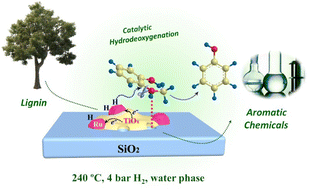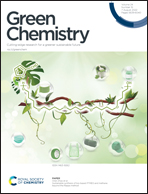Efficient hydrodeoxygenation of guaiacol to phenol over Ru/Ti–SiO2 catalysts: the significance of defect-rich TiOx species†
Abstract
Selective hydrodeoxygenation of lignin-derived phenolics to value-added aromatic products such as phenol with high efficiency and low energy consumption remains an important challenge in the field of biomass conversion. Herein, we fabricated a series of Ti-modified SiO2 supported catalysts (Ru/Ti–SiO2) with rich Ti3+ defects and size-controllable Ru particles via a facile wet impregnation method for the conversion of guaiacol in an aqueous phase. Under relatively mild conditions (240 °C and 0.4 MPa H2), Ru/Ti–SiO2 exhibited higher activity for C–O bond cleavage compared with both Ru/SiO2 and Ru/TiO2 catalysts, and achieved high guaiacol conversion (83.6%) and phenol selectivity (70.4%). The catalytic activity was increased with the introduction of the Ti modifier, and the deoxygenation ability of the Ru/Ti–SiO2 catalyst gradually increased with the Ti content. The presence of Ti–O–Si linkages in the Ti-modified SiO2 support promoted the formation of defect-rich TiOx species, which further inhibited the aggregation of Ru particles and increased their dispersion, regardless of the high reduction temperature and high Ru loading. Besides, those small-sized TiOx interacted with Ru electronically and promoted the formation of Ru0 species. The interface between Ru and TiOx species (Ru0–Ti3+) of the Ru/Ti–SiO2 catalyst was confirmed as the main active sites for the deoxygenation of guaiacol, benefiting the activation of the C–O bond.



 Please wait while we load your content...
Please wait while we load your content...